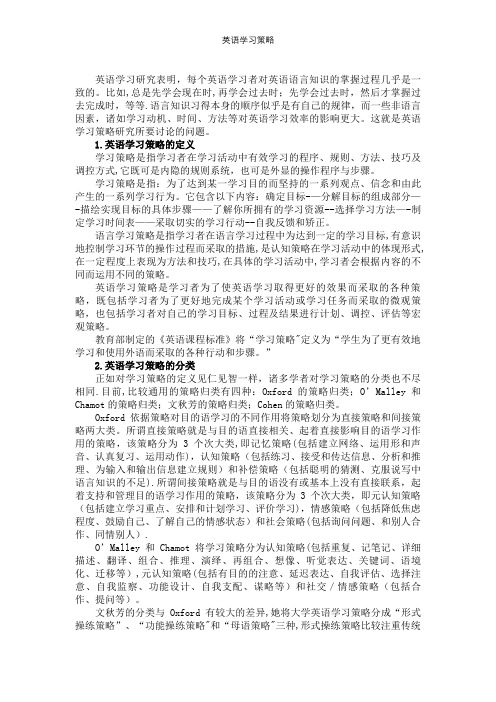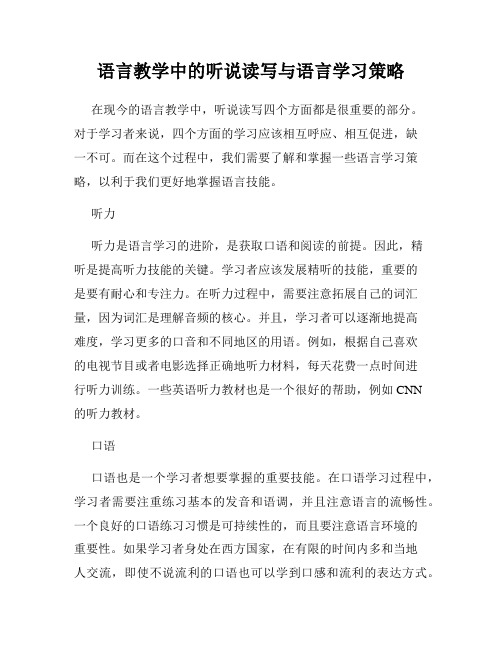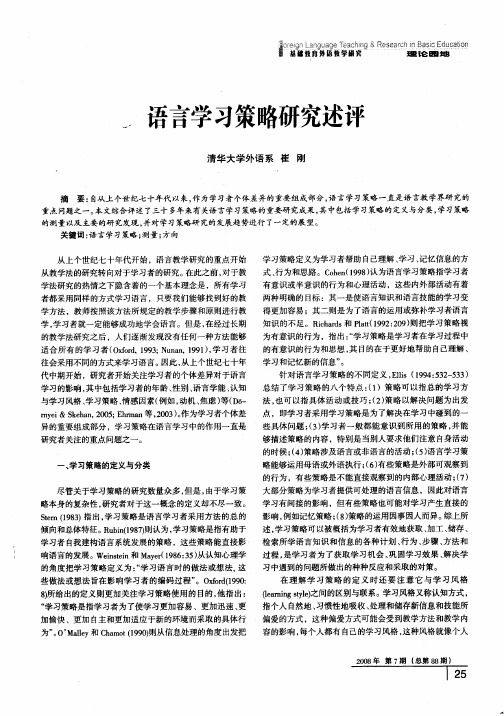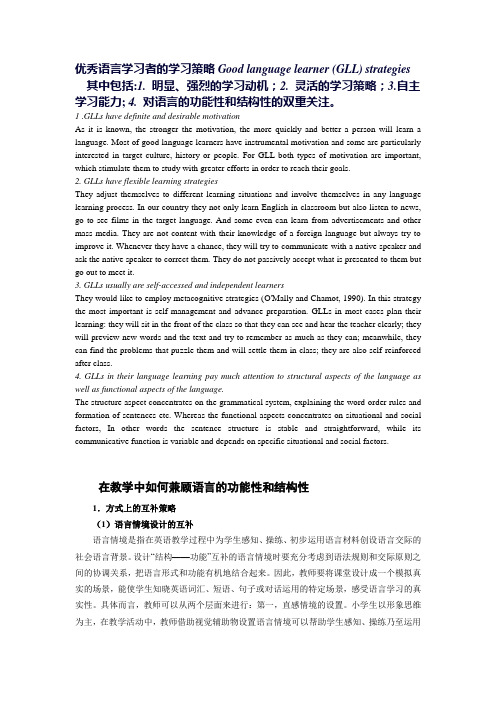优秀语言学习者的学习策略。其中包括1明显强烈的学习
小班语言学习的学习策略指导

小班语言学习的学习策略指导学习语言是小班教育的重要内容之一,有效的学习策略可以帮助幼儿更好地掌握语言技能。
本文将介绍一些适用于小班语言学习的学习策略指导。
一、创设富有语言环境创设富有语言环境是小班语言学习的重要基础。
教师可以通过以下方式来提供语言输入的机会:1. 图书角落:设置一个小角落,放置适合幼儿阅读的图书。
每天定期进行阅读活动,引导幼儿通过阅读来扩展自己的词汇量和语言能力。
2. 语言游戏:通过各种形式的语言游戏,如说故事、角色扮演等,鼓励幼儿主动运用语言进行交流。
同时,教师可以提供必要的词汇和句型支持,帮助幼儿更好地表达自己的意思。
3. 语言模仿:教师可以为幼儿提供一些常见的口头表达,并进行反复的模仿训练,帮助幼儿掌握正确的语音、语调和语速。
二、激发兴趣,培养积极学习态度在小班语言学习中,激发幼儿的兴趣是培养积极学习态度的关键。
以下几点可供参考:1. 唤起情感共鸣:教师可以通过引入童话、故事和有趣的主题活动,唤起幼儿的情感共鸣,引起他们的注意和兴趣。
2. 多媒体辅助:利用多媒体技术,如音频、视频等,给予幼儿丰富的听力材料。
这样可以增加学习的趣味性,提高幼儿对语言学习的兴趣。
3. 奖励机制:设立合理的奖励机制,对于幼儿在语言学习上的积极表现进行及时肯定和奖励,激发他们的学习动力。
三、循序渐进,适应个体差异每个幼儿在语言学习方面的发展存在差异。
为了适应个体差异,教师需要采取相应的策略:1. 引导示范:教师通过示范和引导,帮助幼儿逐渐掌握基本的语言表达方式,比如问候语、基本日常用语等。
2. 分层教学:根据幼儿的语言水平和能力,进行分层教学。
对于语言能力较强的幼儿,可以提供更有挑战性的任务和活动,激发他们的学习兴趣;对于语言能力较弱的幼儿,则可以给予更多的辅助和支持。
3. 自主学习:鼓励幼儿进行自主的学习和探索,提供良好的学习资源和学习环境,激发幼儿的主动性和创造性。
四、互动交流,促进语言输出语言学习不仅仅是接受输入,更重要的是能够输出。
小学教育心理学《当代教育心理学》第十章 学习策略

第十章学习策略第一节学习策略概述随着学习理论的发展,人们越来越认识到:有效的学习者应当被看作是一个积极的信息加工者,解释者和综合者,他能使用各种不同的策略来存储和提取信息,努力使学习环境适应自己的需求和目标。
学习策略是衡量学生学习能力的重要尺度,是会不会学习的重要标志,是制约学生学习效果的主要因素之一。
教师需要有意识地培养和训练学生掌握和使用相应的学习策略,教会学生学习。
一、学习策略的界定在相关研究中,学习策略(learning strategies)的界定始终是一个基本的问题。
各种定义很多,大致可分为三种:①将学习策略视作学习过程中信息加工的程序、方法或规则。
如(Duffy,1982)认为,“学习策略是内隐的学习规则系统。
”平特里奇(P. Pintrich)认为是学生获得信息的技术或方法。
如梅耶(Mayer,1988)认为,“学习策略是学习者有目的地影响自我信息加工的活动”,“是在学习活动中用以提高学习效率的任何活动。
"②视作对学习过程中的信息加工进行调节和控制的技能。
如P200加涅(1985)。
③看作学习过程中信息加工的方法与调控技能的结合。
如Dansereau(1985).如,尼斯比特(Nisbett,1986)认为,“学习策略是选择、整合、应用学习技巧的一套操作过程。
”P200 (Sternberg, 1983) (Dansereau,1985)以上不尽相同的定义,从不同侧面揭示了学习策略的特征。
我国学者也是仁者见仁,智者见智。
有的认为学习策略与认知策略等同。
我们将从学习策略与相关概念的辨析中来把握学习策略的涵义。
学习策略与学习方法学习方法是学习者在一次具体的学习活动中为达到一定的学习目的而采用的手段和措施。
学习方法与学习策略是有区别的:(1)具体的学习方法与具体学习任务相联系,有较强的情境性,而学习策略既与具体任务相联系,又与一般学习过程相联系;(2)学习方法经学习者反复运用,熟练掌握后,学习者在具体情境中往往凭习惯加以运用,而学习策略则是学习者经过对学习任务,学习者自身特点等各方面进行分析,反复考虑之后才产生的方案;(3)具体的学习方法可以用来达到一定的学习目的,完成学习任务,但不考虑最佳效益,而学习策略则是以追求最佳效益为基本点的。
语言学习的关键影响因素有哪些

语言学习的关键影响因素有哪些语言,作为人类交流和思维的重要工具,其学习是一个复杂而又充满挑战的过程。
那么,影响语言学习的关键因素究竟有哪些呢?首先,学习动机是语言学习中至关重要的因素之一。
强烈的学习动机能够激发学习者的积极性和主动性。
如果一个人学习语言是出于对目标语言文化的热爱,或者是为了实现个人职业发展的目标,比如获得更好的工作机会、提升职业竞争力,那么他们往往会更有动力去克服学习过程中遇到的困难。
相反,如果学习动机不明确或者只是为了应付考试,那么一旦遇到挫折,就很容易失去学习的兴趣和动力。
学习环境也是一个不可忽视的因素。
一个良好的语言学习环境可以为学习者提供更多的语言输入和实践机会。
比如,生活在以目标语言为母语的国家或地区,学习者能够随时随地接触到真实的语言场景,听到地道的语言表达,从而更好地培养语感和语言运用能力。
而在国内,如果周围有良好的语言学习氛围,例如参加语言交流活动、加入语言学习社团等,也能够对语言学习起到积极的促进作用。
学习方法对于语言学习的效果有着直接的影响。
科学合理的学习方法能够提高学习效率,让学习者在短时间内取得更好的学习成果。
比如,制定合理的学习计划,合理分配学习时间,注重听说读写的综合训练。
同时,善于运用各种学习资源,如教材、工具书、网络课程、语言学习软件等,也能够丰富学习的途径和方式。
此外,及时总结归纳学习中的重点和难点,不断反思和调整学习方法,也是提高语言学习效果的重要手段。
学习者的年龄也是一个影响语言学习的关键因素。
一般来说,儿童在语言学习方面具有一定的优势。
他们的大脑处于发育阶段,对语言的接受和模仿能力较强,更容易形成地道的语音和语感。
而且,儿童在学习过程中没有太多的心理负担,敢于大胆表达和尝试。
然而,成年人在语言学习方面也并非毫无优势。
他们具有更强的逻辑思维能力和自主学习能力,能够更好地理解语言的语法规则和内在逻辑。
个人的认知风格和学习风格也会对语言学习产生影响。
英语语言学习策略

七. 影响语言学习策略的因素
年龄 学习风 格类型 教师 学习 环境 影响语言学 习策略的因 素 学习者 态度 智力 学习者 动机
个性
Thank you for your attention!
更多资源
/
英语语言学习策略
一. 学习策略的定义
1. Stern (1983):学习策略是语言学习者采用的学习路子总的 倾向或总体特征,而学习技巧是可观察的学习行为的具 体形式。 2. Weinstein and Mayer (1986):学习策略是学习者在学习过程 中为了促进其信息处理过程而采取的行为或形成的思想。 3. Chamot (1987):学习策略是学习者为了优化学习过程、加 强语言知识和信息知识的记忆而采用的技巧、路子或其 它有意识的行为。 4. Rubin (1987):学习策略是学习者自己构造并直接作用于学 习过程、旨在促进学习者语言系统发展的策略。 5. Oxford (1989):语言学习策略是学习者为了使语言学习更 成功、更有目的、更愉快而采取的行为或行动。
学习策略与学习者策略learnerstrategieslearningstrategies学习者策略learnerstrategies学习策略learningstrategies交际策略communicativestrategies社交策略socialstrategies认知策略cognitivestrategies元认知策略metacognitivestrategies摘自wenden根据学习策略的用途分类可分为语言学习中的策略和语言使用中的策略
五. O’Malley 和 Chamot在1990年修订了 在 年修订了 他们的学习策略分类表( 他们的学习策略分类表(共23种): 种
1. 元认知策略,其中包括事先计划、指导注意力、功 能准备、选择注意力等七种策略; 2. 任知策略,包括使用参考资料、重复、分组和分类、 推理等十四种策略; 3. 社交策略,包括提问和澄清、合作两种策略。
对外汉语教学理论-简答题

对外汉语教学理论简答题说明:请根据第二语言教学的理论和实践加以简述。
举例说明在课堂教学中怎样组织交际性训练。
答:交际性练习是课堂教学的重点环节。
组织好交际性练习的要点是:(1)根据教材提供的内容选择适当的语境和话题。
适当的语境和话题是引导学生开口进行表达的基础。
(2)根据话题的特点选择适当的练习方式。
常用的方式有:问答式、陈述式、描写式、讨论式、辩论式。
(3)进行话题练习时不要轻易打断学生的话语。
纠正错误的基本点是:纠正学生常犯的错误和带有普遍性的错误。
对话题练习中需要进行解释的部分,则应分主次和难易,做有针对性和选择性的解释。
外国学生常说“她是漂亮。
”这样的句子。
请你先分析一下产生这种偏误的主要原因,加以改正,并说明理由;再简要说明应采取的教学对策或方法。
参考答案:(1)改为“她很漂亮。
”<(2)理由:汉语中形容词可以直接做谓语,而且形容词往往不单独做谓语,经常在之前加程度副词,比如:很、比较、非常等。
如果没有强调程度高,此时的“很”,是成句的需要,要轻读。
(3)错误原因:受英语的结构影响“she is beautiful.”(4)教学策略:教形容词时,强化“很+形容词”的结构。
(具体步骤及举例请自行设计)试分析“汉斯每天下午都喜欢运运动”这个句子的偏误成因,并加以改正。
说明避免这类偏误应当采取的教学策略和方法。
!1 、是由汉语动词重叠知识泛化造成的偏误.汉语动词重叠有单音节双音节之分.单音节动词重叠为AA式,如笑笑,说说等;双音节动词重叠为ABAB式,如考虑考虑研究研究。
外国学生把这个结构不适当的泛化就说成了“运运动”2、改正:汉斯每天下午都喜欢运动运动。
【3、教学策略:比较法归纳法例子:双音节动词+ 动词ABAB研究研究掂量掂量打扫打扫运动运动单音节动词+ 宾语AA说说看散散步打打球看看电视外国学生常说“我见面了我的朋友”这样的句子。
请你先分析一下产生这种偏误的主要原因,并加以改正;再简要说明应采取的教学对策或方法。
语言学习策略

Cohen (1998)的语言学习策略分类框架
第二语言学习者策略
语言学习策略
语言使用策略
1.确定需要学习的材料 2.把材料分门别类 3.反复接触材料 4.采取措施记忆材料
1.语言提取策略 2.语言演练策略 3.弥补策略 4.交际策略
七. 影响语言学习策略的因素
年龄
学习风 格类型
教师 学习 环境 影响语言学 习策略的因 素
学习者 态度
智力 学习者 动机
个性
需要更完整的资源请到 新世纪教 育网 -
Thank you for your attention!
需要更完整的资源请到 新世纪教 育网 -
六. 学习策略与学习方法
程晓堂等(2002)提出,学习方法和学习策略的区 别类似于足球中“技术”和“战术”的区别。在比赛 中,传球、停球、带球、射门等属于技术问题;而什 么时候传球,什么时候射门则是战术问题。技术固然 重要,但战术决不是可有可无。
需要更完整的资源请到 新世纪教 育网 -
需要更完整的资源请到 新世纪教 育网 -
二. 学习策略与学习者策略(Learner strategies and learning strategies) 学习者策略 (Learner Strategies)
学习策略 交际策略 社交策略 (Learning Strategies) (Communicative strategies) (Social Strategies)
认知策略 (Cognitive Strategies)
元认知策略 (Metacognitive Strategies)
需要更完整的资源请到 新世纪教 育网 -
现代外语教学-复习笔记

现代外语教学绪论我国外语教学存在的问题外语理论研究薄弱(最大问题也是根本原因之一)缺乏专业研究队伍(2)缺乏系统的研究和对重大宏观问题的研究(3)理论研究和教学实际脱节(4)教师理论意识淡薄师资力量不高教学资源匮乏教学理念落后应试倾向明显权钱干扰严重外语教学研究的主要内容和范围(三方面的研究)“本体论”——研究事物的本来面目,为基础研究“实践论”——研究具体实施某一计划的步骤、原则和方法“方法论”——研究达到某一目标的最佳途径中国人学外语的规律:前脑的布罗卡区位置不同;讲中文的人语言功能区位置要高些,更接近大脑运动功能区。
既然中文语言功能区与运动区紧密相连,那么中文要多看多写多说,靠运动来记,而学英文则注重环境,重多听多说,因为英文的语言功能区更靠近听力区。
外语教学研究的若干重要课题本体论研究语言学理论研究、对语言学习的研究、中国人学习英语的其他影响因素实践论研究需求分析、课程设计、课堂教学、过程评估3、方法论研究教学方法和教学目标的关系教师发展研究外语教学质量的高低取决于师资力量的高低理想的外语教师——09年简答优秀的人品扎实的外语基本功良好的研究能力广博的知识较强的课堂组织能力和沟通能力敬业精神第一章当代外语教学理论研究中的几个重要发展趋势第一节从研究如何教到研究如何学原因:(1)越来越重视和强调“以学习者为中心”的教学理念(2)许多教学方法不能达到预期目的,必须研究学习主体(3)越来越意识到学习者之间的各种差异(4)学习者在语言学习过程中的积极主动作用得到证实对学习主体的研究包括:1、学习者个人差异的研究;2、学习过程的研究1、学习者个人差异研究的内容有:年龄、语言潜能、动机、认知风格、性格——10年填空2、学习过程的研究:CA→EA→IL研究重点(两方面)原有知识(母语知识、对语言的一般知识、世界知识)的作用——正负迁移学习着策略研究(重点:学习者策略的定义、学习者策略的分类、在外语过程中的作用、影响学习者使用的因素)第二节语言使用研究和学习着语言使用能力的培养现代语言学研究的一个最大特点是由注重语言形式的分析到注重语言功能的分析,或者说更加注重使用中的语言的研究,如社会语言学、语言学和话语分析。
英语学习策略【精选文档】

英语学习研究表明,每个英语学习者对英语语言知识的掌握过程几乎是一致的。
比如,总是先学会现在时,再学会过去时;先学会过去时,然后才掌握过去完成时,等等.语言知识习得本身的顺序似乎是有自己的规律,而一些非语言因素,诸如学习动机、时间、方法等对英语学习效率的影响更大。
这就是英语学习策略研究所要讨论的问题。
1.英语学习策略的定义学习策略是指学习者在学习活动中有效学习的程序、规则、方法、技巧及调控方式,它既可是内隐的规则系统,也可是外显的操作程序与步骤。
学习策略是指:为了达到某一学习目的而坚持的一系列观点、信念和由此产生的一系列学习行为。
它包含以下内容:确定目标-—分解目标的组成部分—-描绘实现目标的具体步骤——了解你所拥有的学习资源--选择学习方法—-制定学习时间表——采取切实的学习行动--自我反馈和矫正。
语言学习策略是指学习者在语言学习过程中为达到一定的学习目标,有意识地控制学习环节的操作过程而采取的措施,是认知策略在学习活动中的体现形式,在一定程度上表现为方法和技巧,在具体的学习活动中,学习者会根据内容的不同而运用不同的策略。
英语学习策略是学习者为了使英语学习取得更好的效果而采取的各种策略,既包括学习者为了更好地完成某个学习活动或学习任务而采取的微观策略,也包括学习者对自己的学习目标、过程及结果进行计划、调控、评估等宏观策略。
教育部制定的《英语课程标准》将“学习策略"定义为“学生为了更有效地学习和使用外语而采取的各种行动和步骤。
”2.英语学习策略的分类正如对学习策略的定义见仁见智一样,诸多学者对学习策略的分类也不尽相同.目前,比较通用的策略归类有四种:Oxford的策略归类;O’Malley和Chamot的策略归类;文秋芳的策略归类;Cohen的策略归类。
Oxford依据策略对目的语学习的不同作用将策略划分为直接策略和间接策略两大类。
所谓直接策略就是与目的语直接相关、起着直接影响目的语学习作用的策略,该策略分为3个次大类,即记忆策略(包括建立网络、运用形和声音、认真复习、运用动作),认知策略(包括练习、接受和传达信息、分析和推理、为输入和输出信息建立规则)和补偿策略(包括聪明的猜测、克服说写中语言知识的不足).所谓间接策略就是与目的语没有或基本上没有直接联系,起着支持和管理目的语学习作用的策略,该策略分为3个次大类,即元认知策略(包括建立学习重点、安排和计划学习、评价学习),情感策略(包括降低焦虑程度、鼓励自己、了解自己的情感状态)和社会策略(包括询问问题、和别人合作、同情别人).O’Malley和Chamot将学习策略分为认知策略(包括重复、记笔记、详细描述、翻译、组合、推理、演绎、再组合、想像、听觉表达、关键词、语境化、迁移等),元认知策略(包括有目的的注意、延迟表达、自我评估、选择注意、自我监察、功能设计、自我支配、谋略等)和社交/情感策略(包括合作、提问等)。
英语中的语言学习策略知识点

英语中的语言学习策略知识点一、引言在学习英语的过程中,掌握一些有效的语言学习策略是至关重要的。
本文将介绍几个在英语学习中常用的语言学习策略,并分析其应用场景以及效果。
二、反思式学习(Reflective Learning)反思式学习是指学习者在学习英语过程中不仅仅是通过接受知识,而是通过反思来提高自己的学习能力。
反思过程中,学习者可以思考自己在学习中的问题和困难,找出解决方法,并总结经验教训。
三、语言输出(Language Output)语言输出是指学习者主动运用所学语言进行口语或书面表达的过程。
通过频繁的语言输出,学习者可以巩固所学知识,培养语感,提高语言表达能力。
四、语言输入(Language Input)语言输入是指学习者接触和理解英语的过程,包括阅读与听力。
良好的语言输入是建立起正确语感和丰富词汇量的关键。
通过大量的阅读和听力练习,学习者可以扩大自己的语言能力,增加语言输入的量。
五、情境学习(Contextual Learning)情境学习是指学习者通过真实世界中的情境来学习语言。
在情境学习中,学习者将所学语言应用于实际场景,通过与他人的交流和互动,提高语言运用的能力。
六、记忆技巧(Memory Techniques)记忆技巧是帮助学习者更好地记忆英语知识的方法和技巧。
例如,通过制作记忆卡片、使用联想等方法,可以帮助学习者更快更有效地记忆单词和语法规则。
七、多元感官学习(Multisensory Learning)多元感官学习是指通过多种感官的参与来加深对英语学习的理解和记忆。
学习者可以通过看、听、说、做等方式来学习,帮助大脑更好地吸收和处理信息。
八、自主学习(Autonomous Learning)自主学习是指学习者自己根据学习目标和需求进行自我管理和组织学习的过程。
在自主学习中,学习者可以制定学习计划,选择学习资源,培养学习的自觉性和主动性。
九、口语练习(Oral Practice)口语练习是学习英语的关键环节。
学习策略教学的类型、阶段与特点(一)

学习策略教学的类型、阶段与特点(一)摘要:教会学生学习、教会学生思考已成为当前心理学关注的热点问题。
课堂策略教学主要涉及学习策略教学类型、教学阶段和教学的特点。
学习策略教学的类型主要分为通用和学科学习策略,学习策略的教学基本阶段为激发兴趣、策略剖析、策略运用和策略反思四阶段,学习策略教学的特点包括策略的选择、策略的教学要素、策略的教学展示及策略教学的有效性条件诸方面。
关键词:学习策略;教学类型;教学阶段;教学要素;教学的有效性条件Abstract::Greatattentionhasbeenpaidtoteachingstudentshowtolearnandthink,whichi sthehotissueofpsychology.Classroominstructionoflearningstrategyincludest eachingtype,teachingstageandteachingcharacteristics.TheInstructiontypesc ontaintwokinds:generalstrategyandsubjectlearningstrategy.Thebasicclassroominstructionst agesconsistofinterestmotivation,strategyanalysis,strategyapplicationandstr ategyretrospect.Thecharacteristicsofstrategyinstructionincludethechoiceof strategy,elementsofstrategyinstruction,strategypresentationandeffectiveco nditionsofstrategyinstruction.Keywords:learningstrategy;teachingtype;teachingstage;teachingelement;effectiveconditionsofstrategyinstruction教会学生学习、教会学生思考已成为当前教育学家和心理学家的共识,学习策略的教学探讨已成为当前国内外研究甚为关注的问题。
语言教学中的听说读写与语言学习策略

语言教学中的听说读写与语言学习策略在现今的语言教学中,听说读写四个方面都是很重要的部分。
对于学习者来说,四个方面的学习应该相互呼应、相互促进,缺一不可。
而在这个过程中,我们需要了解和掌握一些语言学习策略,以利于我们更好地掌握语言技能。
听力听力是语言学习的进阶,是获取口语和阅读的前提。
因此,精听是提高听力技能的关键。
学习者应该发展精听的技能,重要的是要有耐心和专注力。
在听力过程中,需要注意拓展自己的词汇量,因为词汇是理解音频的核心。
并且,学习者可以逐渐地提高难度,学习更多的口音和不同地区的用语。
例如,根据自己喜欢的电视节目或者电影选择正确地听力材料,每天花费一点时间进行听力训练。
一些英语听力教材也是一个很好的帮助,例如 CNN的听力教材。
口语口语也是一个学习者想要掌握的重要技能。
在口语学习过程中,学习者需要注重练习基本的发音和语调,并且注意语言的流畅性。
一个良好的口语练习习惯是可持续性的,而且要注意语言环境的重要性。
如果学习者身处在西方国家,在有限的时间内多和当地人交流,即使不说流利的口语也可以学到口感和流利的表达方式。
而在教室里,以及独自一人进行练习的时候,也应该使用一些工具和练习技巧来帮助自己进行口语训练,比如口语旋律、练习情景对话、记录自己的语音和发音等等。
阅读阅读是把学习者的语言技能迈向更高水平的关键。
通过阅读,学习者可以学习更多的词汇和语法,同时也能对语言思考方式有更深入的了解。
事实上,许多外语学习者觉得过去的阅读体验受限制,是因为他们花费了大量的时间去翻译单词。
所以,在阅读过程中,阅读中心思想以及理解单词是很重要的。
学习者还可以通过多看一些练习语言理解、翻译和单词识别的文章,以便提高他们的阅读能力。
写作如此强调口语和听力,不是把写作漏了,事实上写作也是学习语言技能的核心之一。
通过写作,学习者可以实践语法、储备词汇,并且通过的纠正口语错误,学习者可以深入的理解语言学习。
为了提高写作技巧,学习者可以通过模仿提高自己的写作水平,同时也可以通过找到一个或者多个写作导师进行写作的辅导。
英语的有效率学习策略和学习方法

英语的有效率学习策略和学习⽅法 众所周知,英语是全球⼴泛使⽤的⼀门语⾔。
对于中国学⽣来说更是⼀门从⼩到⼤都要学习的学科,那么如何有⽬的、有计划、有效率地学习英语,相信是很多学⽣急切想要知道的事情。
所以⼩编整理了以下的英语学习策略和学习⽅法,希望可以对你有所帮助。
⼀、英语学习策略有哪些 1.制定长远⽬标,明确每节课的学习任务。
根据不同学习阶段及⾃⾝能⼒确⽴⼀个“跳⼀跳才能够得着”的长远⽬标。
有了⽬标就有了学习动⼒,有了责任感、紧迫感及努⼒⽅向。
另外还要学会根据不同课型确定每节课的认知⼩⽬标,这样⼀开始上课,就会受到⽬标的激励,使⼤脑处于兴奋状态,才能定向注意,专⼼致志地去主动学习,提⾼学习效率。
2.争取课内外各种机会多练习英语。
语⾔不是教会的,⽽是在使⽤中学会的。
交际能⼒只能在交际中得到最有效的培养。
⼀个出⾊的语⾔学习者应具有强烈的语⾔交际的欲望,应⼒争语⾔训练的各种机会。
应不怕因犯语⾔错误⽽被别⼈讥笑。
3.课前预习。
预习是个⼈独⽴的阅读和思考。
它可以培养学习者快速阅读抓主旨⼤意、抓主要信息、依据上下⽂猜测词义的能⼒,也可以培养分析综合及归纳概括、⾃⼰发现问题及解决问题等能⼒。
预习也像“⽕⼒侦察”,可发现疑难引起思考,⼀⽅⾯可促使学习者⾃⼰查阅有关资料,查阅字典,另⼀⽅⾯可减少听课的盲⽬性,增强听课效果。
4.专⼼上课,有⼼识记。
上课是学⽣学习的主渠道,⽽学好外语的关键是尽⼀切努⼒将所学的东西记住,需要时能运⽤⾃如。
因此,上课时应⾼度集中注意⼒.尽量做到五到,即⼼到、眼到、⽿到、⼝到、⼿到。
应培养瞬间记忆能⼒,强化“有意注意”,争取就在课内有⽬标、有意识地去识记该课的⽣词、短语、句型、重点句⼦。
当接触到该记忆的内容时,应通过眼看、⽿听、⼝念,将其迅速输⼊到记忆中枢,然后再复现出它的形象。
在复现时快速⽤⼿指在桌上划出这个单词,或⼀个长句中最难记的或最重要的单饲,强迫⾃⼰在课内就能记住这节课最重要的东西。
语言学习的关键因素及有效方法

语言学习的关键因素及有效方法语言学习是一项艰巨而又充满挑战的任务。
无论是学习外语,还是掌握母语的更高层次,都需要付出大量的努力和时间。
然而,有些人似乎能够轻松地掌握多种语言,而有些人却在学习过程中遇到了困难。
这引发了人们对语言学习的关键因素及有效方法的探索和研究。
首先,语言学习的关键因素之一是动机。
学习一门语言需要持续的动力和热情。
如果缺乏兴趣和动力,学习过程将会变得枯燥乏味,难以坚持下去。
因此,培养学习语言的兴趣和动机是非常重要的。
可以通过与母语人士交流、阅读有趣的文章和书籍、观看电影和电视剧等方式来激发学习语言的兴趣。
其次,语言学习的关键因素之二是语言环境。
语言环境对于学习语言的影响是巨大的。
如果身处一个能够提供大量语言输入和输出机会的环境中,学习语言会更加容易。
在语言环境中,学习者可以通过与母语人士交流、观察和模仿他们的用语和表达方式来提高语言能力。
因此,创造一个良好的语言环境对于语言学习至关重要。
此外,语言学习的关键因素之三是学习策略。
学习策略是指学习者在学习过程中采取的方法和技巧。
不同的学习者可能适用不同的学习策略,因此找到适合自己的学习策略是非常重要的。
一些常见的学习策略包括:制定学习计划,分解学习目标,积极参与课堂讨论,使用词汇卡片和语法练习等。
通过合理的学习策略,学习者可以更加高效地掌握语言知识和技能。
另外,语言学习的关键因素之四是语言输入和输出的平衡。
语言输入指的是学习者接收到的语言信息,而语言输出则是学习者自己产生的语言表达。
在语言学习过程中,保持输入和输出的平衡非常重要。
通过大量的输入,学习者可以积累词汇和语法知识,提高听力和阅读能力。
而通过输出,学习者可以巩固所学知识,提高口语和写作能力。
因此,学习者应该注重培养听、说、读、写四个方面的语言能力,避免只重视其中某一个方面。
最后,有效的语言学习方法也是至关重要的。
学习方法的选择直接影响到学习效果。
一种常见的有效学习方法是多种形式的学习结合。
小班教学中的语言学习策略

小班教学中的语言学习策略在小班教学中,语言学习策略是促进幼儿语言发展的重要手段。
通过运用合适的语言学习策略,教师可以帮助幼儿扩大词汇量,提高语言表达能力,并促进他们在语言交流中的自信和积极性。
本文将介绍小班教学中的一些有效的语言学习策略,并探讨其实施方法和效果。
一、以游戏为主导的学习策略在小班教学中,游戏是幼儿学习语言的最佳活动之一。
教师可以设计各种有趣的语言游戏,通过游戏帮助幼儿积极参与、主动表达。
例如,可以组织幼儿进行角色扮演,让他们在扮演不同角色的过程中学习和运用新的词汇和句型。
同时,教师还可以设计一些配套的语言游戏,如拼图游戏、看图说话等,引导幼儿运用学到的知识进行交流。
二、启发式教学策略启发式教学策略是指通过启发幼儿的思维,引导他们主动参与和发现语言规律。
教师可以提出一些引导性的问题,激发幼儿思考和探索。
例如,在进行词汇教学时,教师可以给出一张图片,然后提问:“你能说出这个图片中的物品是什么吗?”通过这样的启发性提问,幼儿可以通过观察和思考,自己尝试使用新的词汇进行表达。
三、情境教学策略在小班教学中,情境教学策略可以提供一个真实的语言环境,让幼儿在实际情境中学习和运用语言。
例如,教师可以模拟日常生活中的场景,如购物、做饭等,在这些情境中引导幼儿进行语言交流。
同时,教师还可以邀请家长和其他幼儿一起参与,扩大幼儿的语言交际圈,让他们在交流中不断学习和提高。
四、多媒体教学策略多媒体教学策略利用现代科技手段,将图像、音频、视频等多种媒体形式结合起来,提供丰富的语言学习资源。
教师可以通过使用幼儿喜欢的动画片、儿歌、故事书等,吸引幼儿的注意力,激发他们学习语言的兴趣。
同时,教师还可以利用多媒体教学手段进行互动教学,鼓励幼儿参与到语言学习中,提高学习效果。
五、评估和反馈策略评估和反馈策略在语言学习中起到至关重要的作用。
教师可以通过观察幼儿的表现、记录其语言发展情况来评估幼儿的学习进度。
同时,教师还可以定期与幼儿进行交流,给予积极的反馈和鼓励。
语言学习策略研究述评

学 习者 自 我建构语言系统发展的策略 ,这些 策略能直接影
响语言 的发展。We s i Mae(9 6 3 ) i t n和 yr1 8 :5 从认知心理学 ne
的角度 把学 习策略定义为 :学 习语 言时 的做法 或想法, “ 这
些 做法 或想 法 旨在影响学 习者的编码过程 ” x r(9 0 。O f d19 : o
在理 解 学 习策 略的 定 义时 还 要 注 意它 与 学 习 风格 (a i y ) 1 r n s l之间的区别与联系。 习风格又称认 知方式 , e n g te 学 指个人 自 然地 、 习惯性 地吸收 、 处理和储存新信息和技能所
偏爱 的方式 ,这种偏爱方式可能会受到教学方法和教学 内
重点 问题之 一。 本文综合评述 了三十 多年 来有 关语言学 习策略 的重要研究成果 , 中包括 学习策略 的定 义与分类, * 其 学- 7策略
的测量以及主要 的研 究发现 , 并对学 习策略研 究的发展趋势进行 了一定的展望。 关键词 : 言学 习策略 ; 语 测量 ; 方向
从 上个世纪七十年代开始 ,语言教学研究的重点开始 从教学 法的研究转向对于学 习者的研究。 在此之前 , 于教 对 学法研 究的热情之下 隐含着 的一个基本理念是 ,所有学习 者都采用 同样 的方式学 习语言 ,只要我们能够找到好的教
大部分策略为学 习者提供可处理 的语言信息 ,因此对语 言
学习有间接的影响 ,但有些策略也可能对学习产生直接的
影响 , 例如记忆策略 ;8 策略的运用 因事因人而异 。 () 综上所
述, 学习策略可以被概 括为学 习者有效地获取 、 加工 、 、 储存 检索所学语 言知识和信 息的各种计划 、 为 、 行 步骤 、 和 方法 过程 , 是学 习者 为了获取学 习机会 、 巩固学 习效果 、 解决 学
一、优秀语言学习者的学习策略

一、优秀语言学习者的学习策略首先,强烈的学习动机。
当学习欲望越强烈时,学生的学习和接受能力就越强,效果也越好。
其次,灵活的学习策略。
优秀的语言学习者在面对不同的学习情况时,能迅速调整自己的学习方法。
再者,自主的学习能力。
优秀的语言学习者能科学地规划自己的学习。
具体体现为他们会自觉地做好课前预习及课后复习的工作;他们会积极找出自己在学习上的不足并在老师或同学的帮助下及时地解决这些问题;在上课时,他们往往会选择坐在教室前排,以便能清楚地看到及听到老师,从而提高其学习效率。
最后,对语言的功能性和结构性的双重关注。
优秀的语言学习者不仅关注对语言知识的理解和记忆,还关注语言的实际运用功能二、在教学中如何兼顾语言的功能性和结构性?若要实现在教学中要兼顾语言的功能性和结构性,这不仅需要将教学内容有机互补,更需要注重语言结构又注重语言的语用功能。
同时,教学中更应注重教学方法的互补,即从两种不同的教学方法或技巧出发,探讨方法上的结合。
结构法的教学方法是利用行为主义的理论培养学生的口语流利程度和对语言知识的记忆,让学生对所学语言的输出能达到相当的熟练程度。
在日常教学实践中,教师应注重教学方法的有机互补:第一,语言情境设计的互补。
运用互补的语言情境时要充分考虑到语法规则和交际原则之间的协调关系,把语言形式和功能有机地结合起来。
因此,教师要将课堂设计成一个模拟真实的场景,能使学生知晓英语词汇、短语、句子或对话运用的特定场景,感受语言学习的真实性。
第二,在教学过程中进行学与用的互补,就是教师根据教学目标和教学内容的特点,频繁地指导学生交替进行语言知识的学习与运用。
第三,输入与输出的循环互补。
英语教学中输入与输出的循环互补指教师根据教学目标和教学内容的需要,通过生动活泼的方式,即时在教师、学生提供的刺激与有关学生的反应之间多次交替进行。
第四,课堂教学与课外活动的互补。
但是,英语课堂教学的实践告诉我们,听、说、读、写作为英语教学的四项基本技能不应将它们机械地割裂开来,应该根据教学目标的要求和教学内容的特点,循环交替进行四项基本技能的练习。
优秀语言学习者的学习策略Good language learner (GLL)

优秀语言学习者的学习策略Good language learner (GLL) strategies 其中包括:1.明显、强烈的学习动机;2.灵活的学习策略;3.自主学习能力; 4.对语言的功能性和结构性的双重关注。
1 .GLLs have definite and desirable motivationAs it is known, the stronger the motivation, the more quickly and better a person will learn a language. Most of good language learners have instrumental motivation and some are particularly interested in target culture, history or people. For GLL both types of motivation are important, which stimulate them to study with greater efforts in order to reach their goals.2. GLLs have flexible learning strategiesThey adjust themselves to different learning situations and involve themselves in any language learning process. In our country they not only learn English in classroom but also listen to news, go to see films in the target language. And some even can learn from advertisements and other mass media. They are not content with their knowledge of a foreign language but always try to improve it. Whenever they have a chance, they will try to communicate with a native speaker and ask the native speaker to correct them. They do not passively accept what is presented to them but go out to meet it.3. GLLs usually are self-accessed and independent learnersThey would like to employ metacognitive strategies (O'Mally and Chamot, 1990). In this strategy the most important is self-management and advance preparation. GLLs in most cases plan their learning: they will sit in the front of the class so that they can see and hear the teacher clearly; they will preview new words and the text and try to remember as much as they can; meanwhile, they can find the problems that puzzle them and will settle them in class; they are also self-reinforced after class.4. GLLs in their language learning pay much attention to structural aspects of the language as well as functional aspects of the language.The structure aspect concentrates on the grammatical system, explaining the word-order rules and formation of sentences etc. Whereas the functional aspects concentrates on situational and social factors, In other words the sentence structure is stable and straightforward, while its communicative function is variable and depends on specific situational and social factors.在教学中如何兼顾语言的功能性和结构性1.方式上的互补策略(1)语言情境设计的互补语言情境是指在英语教学过程中为学生感知、操练、初步运用语言材料创设语言交际的社会语言背景。
语言学习中的学习风格和学习策略

语言学习中的学习风格和学习策略语言学习对于非母语者来说往往是一项令人心生畏惧的任务,但是在掌握合适的学习风格和学习策略下,学习语言将迅速变得更加容易和有趣。
学习风格是影响个体学习结果和效率的一种方式,而对于语言学习来说,选择适合自己的学习风格是至关重要的。
学习风格可以分为视觉型、听觉型、动觉型等不同类型。
视觉型学习者更容易通过看图、画图等视觉方式进行学习;听觉型学习者则倾向于通过听说的方式来掌握语言知识;而动觉型学习者则通过实际操作和动手实践来提高语言能力。
在选择学习风格时,个体可以结合自身的特点和偏好,以及学习环境的实际情况进行判断,并灵活地调整自己的学习策略。
除了学习风格外,学习策略也是语言学习中不可或缺的一部分。
学习策略是指学习者在学习过程中采用的特定方法和技巧,以提高学习效果。
在语言学习中,有几种常见的有效学习策略:首先,语言学习者可以通过频繁和系统地暴露自己于目标语言的环境中。
这包括在日常生活中积极使用目标语言,例如与母语者进行交流、观看目标语言的电影和电视节目等。
通过这种方式,学习者可以更好地理解和掌握目标语言的表达方式、语法结构和惯用语等。
其次,记忆方法也是学习策略中的一项重要内容。
在语言学习中,记忆单词和短语是必不可少的一环。
学习者可以通过使用记忆法,例如构建联想、制作记忆卡等方式,将目标语言的词汇牢记于心。
此外,学习者还可以通过不断地重复、复习以及运用所学的知识,以巩固记忆效果。
此外,积极的自主学习也是一个重要的学习策略。
学习者可以通过利用网络资源、阅读相关的书籍和文章,以及参加语言学习的培训班等方式,积极主动地进行学习。
同时,建立学习计划和设定学习目标,将学习过程分成具体的阶段和目标,也有助于提高学习效率。
最后,合理地进行口语和书面练习也是一种有效的学习策略。
语言学习不仅需要理解和记忆,更需要通过实践来提高自己的口语和书写能力。
通过与他人进行口语练习,学习者可以更好地运用所学的语言知识,并提高自己的表达能力。
学习策略和学习风格

学习策略和学习风格在当今信息爆炸的社会中,学习成为人们不可或缺的一部分。
然而,不同的人在学习过程中采用了不同的策略和风格。
本文将探讨学习策略和学习风格的定义、特点以及对学习效果的影响。
一、学习策略的定义与特点学习策略是指个体在学习过程中有意识或无意识地采用的一系列方法、技巧和活动,以促进自己的学习效果。
不同的学习策略适用于不同的学科和学习目标,它们的特点如下所示。
1. 聚焦性学习策略:这种学习策略注重思考和理解,采用主动参与的方式来提高对学习材料的理解。
其中包括主动提问、讨论和示例分析等。
2. 重复性学习策略:这种学习策略通过反复练习和记忆来巩固知识。
它适用于需要记忆大量信息的学科,例如历史、地理等。
3. 呈现性学习策略:这种学习策略通过图像、图表和实例等呈现方式来帮助理解知识,提高学习效果。
例如,制作概念图、思维导图和案例分析等。
4. 合作性学习策略:这种学习策略通过与他人合作学习,共同解决问题,促进知识的理解和掌握。
其中包括小组讨论、合作项目和互助学习等。
二、学习风格的定义与特点学习风格是指个体在学习过程中表现出来的偏好和习惯。
每个人有其独特的学习风格,它受到个体的认知、感知和情感等因素的影响。
下面是常见的学习风格及其特点。
1. 视觉型学习风格:这种学习者更喜欢通过看和观察来获取信息。
他们喜欢图像、图表和实物展示等视觉材料,对空间布局和颜色有较高的敏感度。
2. 听觉型学习风格:这种学习者更喜欢通过听和说来学习。
他们喜欢听讲座、参加讨论和口头表达,对声音和语调有较高的敏感度。
3. 动觉型学习风格:这种学习者更喜欢通过动手和动作来学习。
他们喜欢动手实践、参与实验和运动等,对物理接触和动作协调性有较高的敏感度。
4. 阅读写作型学习风格:这种学习者更喜欢通过阅读和写作来学习。
他们喜欢阅读书籍、文章和笔记,对文字和语言能力有较高的敏感度。
三、学习策略与学习风格对学习效果的影响学习策略和学习风格之间存在着密切的关联,并且它们对学习效果有着重要的影响。
- 1、下载文档前请自行甄别文档内容的完整性,平台不提供额外的编辑、内容补充、找答案等附加服务。
- 2、"仅部分预览"的文档,不可在线预览部分如存在完整性等问题,可反馈申请退款(可完整预览的文档不适用该条件!)。
- 3、如文档侵犯您的权益,请联系客服反馈,我们会尽快为您处理(人工客服工作时间:9:00-18:30)。
优秀语言学习者的学习策略。
其中包括:1. 明显、强烈的学习动机;2. 灵活的学习策略;3.自主学习能力;4. 对语言的功能性和结构性的双重关注。
1.GLLs have definite and desirable motivationAs it is known, the stronger the motivation, the more quickly and better a per son will learn a language. Most of good language learners have instrumental m otivation and some are particularly interested in target culture, history or peopl e. For GLL both types of motivation are important, which stimulate them to st udy with greater efforts in order to reach their goals.2. GLLs have flexible learning strategiesThey adjust themselves to different learning situations and involve themselv es in any language learning process. In our country they not only learn Englis h in classroom but also listen to news, go to see films in the target language. And some even can learn from advertisements and other mass media. They ar e not content with their knowledge of a foreign language but always try to im prove it. Whenever they have a chance, they will try to communicate with a n ative speaker and ask the native speaker to correct them. They do not passivel y accept what is presented to them but go out to meet it.3. GLLs usually are self-accessed and independent learnersThey would like to employ metacognitive strategies (O'Mally and Chamot, 199 0). In this strategy the most important is self-management and advance prepara tion. GLLs in most cases plan their learning: they will sit in the front of the class so that they can see and hear the teacher clearly; they will preview new words and the text and try to remember as much as they can; meanwhile, th ey can find the problems that puzzle them and will settle them in class; they are also self-reinforced after class.4. GLLs in their language learning pay much attention to structural as pects of the language as well as functional aspects of the language. The structure aspect concentrates on the grammatical system, explaining the wo rd-order rules and formation of sentences etc. Whereas the functional aspects c oncentrates on situational and social factors, In other words the sentence struct ure is stable and straightforward, while its communicative function is variable and depends on specific situational and social factors.在教学中如何兼顾语言的功能性和结构性1.方式上的互补策略(1)语言情境设计的互补语言情境是指在英语教学过程中为学生感知、操练、初步运用语言材料创设语言交际的社会语言背景。
设计“结构——功能”互补的语言情境时要充分考虑到语法规则和交际原则之间的协调关系,把语言形式和功能有机地结合起来。
因此,教师要将课堂设计成一个模拟真实的场景,能使学生知晓英语词汇、短语、句子或对话运用的特定场景,感受语言学习的真实性。
具体而言,教师可以从两个层面来进行:第一,直感情境的设置。
小学生以形象思维为主,在教学活动中,教师借助视觉辅助物设置语言情境可以帮助学生感知、操练乃至运用知识。
第二,语言情境的设置。
对于英语中一些非实意动词或名词的教学,教师一般可采用用英语语言设置情境的方法帮助学生了解并掌握语言材料。
(2)教学过程中学与用的互补在教学过程中进行学与用的互补,就是教师根据教学目标和教学内容的特点,频繁地指导学生交替进行语言知识的学习与运用。
具体而言,在进行以掌握语言结构为主要目标的教学中,教师要通过设置逼真的情境、游戏、角色扮演、讲故事等方法让学生灵活地、生动地运用有关知识,以巩固语言结构的学习;在进行以语言交际为主要目标的教学中,教师要根据学生在交际中存在的普遍问题,通过操练语言结构,让学生掌握扎实的语言知识。
(3)输入与输出的循环互补英语教学中输入与输出的循环互补指教师根据教学目标和教学内容的需要,通过生动活泼的方式,即时在教师、学生提供的刺激与有关学生的反应之间多次交替进行。
促进输入与输出循环互补的教学策略与方法有:全身反应法,信息——交换、互动策略,故事——语量输入策略等。
(4)课堂教学与课外活动的互补课堂教学作为英语学习的主要途径,对学生掌握语言结构以及应用有关知识有着十分重要的意义。
英语课外活动作为课堂教学的补充,在发展学生的语言交际能力方面有着独特的价值。
我校利用外宾接待活动,让学生在接待外宾的活动中发展他们的语言交际能力,同时,通过开展英语角、表演课本剧等活动发展学生综合的语用能力。
(5)听、说、读、写的交叉互补听、说、读、写作为英语教学的四项基本技能,在教学中,不应将它们机械地割裂开来,应该根据教学目标的要求和教学内容的特点,循环交替进行四项基本技能的练习。
我校教师在教学中,往往把四项基本技能作为一个整体序列,循环交替进行。
2、教学方法上的互补策略除了在方式上的互补外,我们还在教学实践中总结、提炼出了一套与相关教材相应的教学策略,包括:情境化策略、游戏化策略、媒体化策略、故事——语量输入策略、信息——交换互动策略。
(1)情境化策略情境化是指在英语教学过程中为学生感知、操练、初步运用语言材料创设语言交际的社会语言背景。
情境教学能使抽象的语言具体化、情境化和形象化。
教师将课堂设计成一个模拟真实的场景,能使学生知晓英语词汇、短语、句子或对话运用的特定场景,感受语言学习的真实性。
在运用该策略时,要注重直观情境的设置和语言情境的设置。
(2)游戏化策略游戏活动是小学英语课堂教学的一种重要形式。
在课堂教学中营造一种轻松愉快的游戏氛围,能使学生在生动活波的游戏活动中习得语言的知识与技能。
这种策略主要有角色扮演法和全身反应法。
角色扮演指的是教师根据课文内容,让学生分别承担不同的角色进行会话表演,制作简单的道具,利用教师作为舞台进行表演等。
它能使学生亲临其境,将自己的思想、感情渗入到活动中,使角色交际逐步向自然交际发展。
全身反应法指的时教师先把教学内容设计成一系列指令式的语言项目,然后要求学生对这些项目用身体做出反应,它能通过身体对语言的反应动作来提高理解力,学生不仅通过对听到的语言材料的理解,将语言知识内化,从而达到促使学生自然开口说话的目的。
(3)媒体化策略在英语教学中,具体的、直观的、动态的事物容易引起学生的注意,生动形象、直观有趣、富有变化的教学方法符合它们的认知特点。
此外,在教学中直观媒体有益于培养学生逐步养成用英语直接思维的习惯。
在使用该策略时,需要注重:静态媒体的运用和动态媒体的运用。
静态媒体往往运用在在教学的起始阶段,每当教学生一些实意名词或是简单的表示状态的句子时,学校总是把事物、图片、投影等直观静态媒体带入课堂,帮助学生把英语与直观物体建立联系。
动态媒体往往运用在教学中教师往往用动作或表情来教一些表示感觉或状态的词等。
教师还用此方法教给学生祈使句、现在进行时等句式,使学生在理解句子所表达意思的同时,学生揭示句子使用的场合。
在学生学习过程中,学校教师始终要求学生在学说话的同时用肢体动作和脸部表情表示出来,发挥各种身体器官的记忆功能。
(4)故事——语量输入策略这种策略是通过讲故事的方式将结构法与功能法相结合,语言结构和语言功能相结合,操练与情景相结合进行语言教授的方法。
故事的趣味性和生动性有利于情景的创设和氛围的营造,有利于功能法的运用,因而,能够培养学生的语言运用的能力、意识,增强学生对英语语言的情感,培养学生运用英语语言展开联想。
(5)信息——交换互动策略该策略就是教师向交际双方提供不同片段的信息,交际双方通过交流,传递信息,填平信息差。
形成信息差的双方可以是学生也可以是教师和学生。
在深刻理解了信息差的运用原理的基础之上,我校的英语教师细化了信息差的运用,利用各种各样不同程度的信息差将结构法语功能法紧密得结合起来,形成了自己的特色,即阶梯式信息差的运用。
